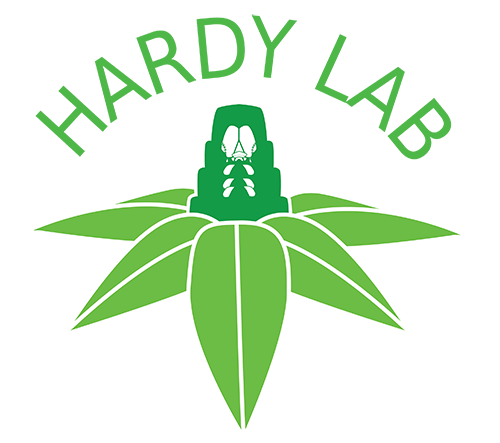Valid Names Results
Peliococcus Borchsenius, 1948 (Pseudococcidae)Nomenclatural History
- Spinococcus Kiritchenko 1931: 314. . nomen nudum
- Acanthococcus Kiritchenko 1936a: 155. Type species: Acanthococcus marrubii Kiritshenko by monotypy . synonym and homonym (discovered by Borchs1949: 203) Notes: Homonym of Acanthococcus Signoret, 1875.
- Peliococcus Borchsenius 1948a: 954. Type species: Phenacoccus chersonensis Kiritshenko by original designation . (= Peliococcus chersonensis, (Kiritshenko, 1936) ) accepted valid name
- Spinococcus Borchsenius 1949: 203. . replacement name that is a synonym (discovered by Danzig2001: 123-124) Notes: Replacement name for Acanthococcus Kiritchenko 1936
- Cyclococcus Ferris 1950b: 116. . nomen nudum
- Parapedronia Balachowsky 1953: 283. Type species: Pedronia spinigera Goux by original designation . junior synonym (discovered by Danzig2001: 123)
- Eupeliococcus Savescu 1985: 116. Type species: Eupeliococcus tragopogoni Savescu by subsequent designation . nomen nudum (discovered by DanzigGa2014: 401)
Remarks
- Systematics: Subfamily: Phenacoccinae (Choi & Lee) Danzig (2001) regarded Parapedronia and Spinococcus as synonyms of Peliococcus. Most Peliococcus species have cerarii of usual type, similar to the cerarii on the majority of other mealybug genera (according to Danzig (2001), who referred to this type of cerarius as "Peliococcus type"), but in some cases (the type species of Peliococcus and species included previously in Spinococcus), each cerarius is on an elevated area with two enlarged conical setae situated close together, and with trilocular pores closely associated with the base of the enlarged setae, sometimes even touching the basal socket (Danzig, 2001)
Both Spinococcus Kiritchenko and Acanthococccus Kiritchenko are unavailable, the former being a nomen nudum and the latter a homonym. Therefore, Borchsenius' (1949) reference to Spinococcus, incorrectly attributed to Kiritchenko, together with a diagnosis, effectively provided a replacement name for Acanthococcus Kiritchenko. Eupeliococcus was described by Săvescu (1985) with two species from Romania, but Săvescu did not designate a type species and, therefore, according to Article 13.3 of the International Code of Zoological Nomenclature (4th ed.), the name Eupeliococcus must be considered a nomen nudum. (Danzig & Gavrilov-Zimin, 2014)
- Structure: Adult female. Covered with white powdery wax in life. Ovisac woolly, white. Antennae generally 9 segmented (7 or 8 segmented in P. calluneti, 8 segmented in P. spinigerus). Eyes oval, protruding on small basal cones. Labium 3 segmented, always longer than wide. Posterior spiracles always larger than anterior pair. Circulus present, rarely absent, lying between abdominal segments III and IV. Legs well developed; claw with a denticle; tarsal digutules hair-like, not capitate; claw digitules knobbed, subequal in length; claw digitules thicker than tarsal digitules. Both pairs of ostioles well developed, but anterior ostioles usually more weakly developed than posterior pair. Anal lobes well developed. Anal ring oval, with 1 inner row of pores, 1 or 2 outer rows of pores and 6 setae. (Kaydan, 2015)
- General Remarks: Good definition and characters given by Borchsenius (1949). Definition and characters given by Balachowsky (1953), Danzig (2001).
Keys
- Kaydan2015: pp.209 ( Adult (F) ) [Key to the genera of the Peliococcus species-group ]
- DanzigGa2014: pp.387 ( Adult (F) ) [Genera of Palearctic g/g Peliococcus]
- Moghad2013: pp.7-8 ( Adult (F) ) [Key to genera of Iranian Pseudococcidae based on adult female morphology]
- Millar2002: pp.189-195 ( Adult (F) ) [Pseudococcidae genera of South Africa]
- Danzig2001: pp.124-125 ( Adult (F) ) [Russia and Palaeartci region]
- Koszta1996: pp.146 ( Adult (F) ) [Northeastern North America]
- Tang1992: pp. ( Adult (F) ) [China]
- Tang1992: pp.554-555 ( Adult (F) ) [species China]
- Danzig1988: pp.697 ( Adult (F) ) [Far East of Russia]
- KosztaKo1988F: pp.62 ( Adult (F) ) [Central Europe]
- KosztaKo1988F: pp.154 ( Adult (F) ) [species Central Europe]
- Willia1985: pp.36 ( Adult (F) ) [Australia]
- Kozar1984: pp.130 ( Adult (F) ) [species Hungary]
- Danzig1980b: pp.120 ( Adult (F) ) [Far East Russia]
- Terezn1975: pp.160 ( Adult (F) ) [Ukraine & Palaearctic region]
- Terezn1975: pp.257 ( Adult (F) ) [species Ukraine]
- Terezn1975: pp.159 ( Adult (F) ) [Ukraine & Palaearctic region]
- TerGri1973: pp.38 ( Adult (F) ) [Armenia]
- TerGri1973: pp.38 ( Adult (F) ) [Armenia]
- TerGri1973: pp.128 ( Adult (F) ) [species Armenia]
- Bazaro1971c: pp. ( Adult (F) ) [Central Asia]
- Bazaro1971a: pp. ( Adult (F) ) [USSR]
- McKenz1967: pp.45 ( Adult (F) ) [North America]
- Balach1953: pp.284 ( Adult (F) ) [Marocco]
- Ferris1953a: pp.282 ( Adult (F) ) [North America]
- Ferris1950b: pp.21 ( Adult (F) ) [North America]
- Borchs1949: pp.89 ( Adult (F) ) [Palaearctic region ]
- Borchs1949: pp.242-244 ( Adult (F) ) [Palaearctic region]
- Borchs1949: pp.88 ( Adult (F) ) [Palaearctic region]
- Borchs1949: pp.203-204 ( Adult (F) ) [Palaearctic region]
Associated References
- Balach1953: taxonomy, pp. 282, 283
- BenDov1994: catalog, pp. 152, 282, 290-291, 493-494
- Borchs1948a: description, taxonomy, pp. 954
- Borchs1949: description, taxonomy, pp. 203-204, 241-244
- Danzig1960: taxonomy, pp. 176
- Danzig1980b: taxonomy, pp. 109, 118-120
- Danzig2001: description, taxonomy, pp. 123-154
- DanzigGa2014: description, key, taxonomy, pp. 401-406
- DeLott1969: description, taxonomy, pp. 25
- Ferris1950b: description, taxonomy, pp. 115
- Goux1989a: description, taxonomy, pp. 301-302
- Goux1990a: description, taxonomy, pp. 77-79
- Kaydan2014: taxonomy, pp. 202,209
- Kiritc1931: taxonomy, pp. 314
- Kiritc1936a: taxonomy, pp. 155
- Koszta1996: description, taxonomy, pp. 77, 145-146
- KosztaKo1988F: description, taxonomy, pp. 117-119, 153-154
- Kozar1984: description, taxonomy, pp. 129
- KwonDaPa2003: taxonomy, pp. 114
- Millar2002: taxonomy, pp. 185-233
- Moghad2013: distribution, taxonomy, pp. 8, 39
- MoghadWa2022: diagnosis, key, pp. 21, 78
- MorrisMo1966: taxonomy, pp. 53, 146, 151, 187
- Savesc1985: description, taxonomy, pp. 116-117
- Tang1992: description, taxonomy, pp. 512, 553-554
- Tao1999: taxonomy, pp. 22, 28
- TerGri1973: description, taxonomy, pp. 127-128, 175-176
- Terezn1975: description, taxonomy, pp. 200, 257
- Willia1962: description, taxonomy, pp. 6, 31, 56
- Willia1985: description, taxonomy, pp. 35, 257
37 Species
- Peliococcus africanus
- Peliococcus agriensis
- Peliococcus bantu
- Peliococcus bavaricus
- Peliococcus caillardi
- Peliococcus calluneti
- Peliococcus chersonensis
- Peliococcus convolvuli
- Peliococcus courzius
- Peliococcus flaveolus
- Peliococcus globulariae
- Peliococcus jartaiensis
- Peliococcus latitubulatus
- Peliococcus lavandulae
- Peliococcus loculatus
- Peliococcus locustus
- Peliococcus marrubii
- Peliococcus martinezi
- Peliococcus mathisi
- Peliococcus morrisoni
- Peliococcus multispinus
- Peliococcus ocanae
- Peliococcus orophilus
- Peliococcus phyllobius
- Peliococcus plurimus
- Peliococcus rosae
- Peliococcus schmuttereri
- Peliococcus serratus
- Peliococcus slavonicus
- Peliococcus spiniger
- Peliococcus subcorticicola
- Peliococcus tbilisiensis
- Peliococcus trispinosus
- Peliococcus turanicus
- Peliococcus unitubulatus
- Peliococcus vivarensis
- Peliococcus zillae


